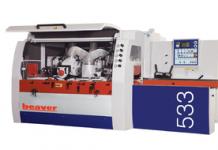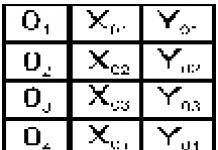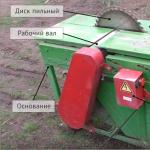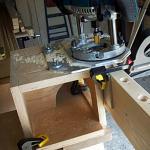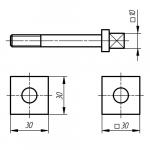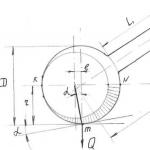Using tongue-and-groove joints at home will allow you to independently create beautiful furniture that is also reliable. Even the frames of low-rise buildings are connected using this scheme, especially when it comes to serious loads during operation. Therefore, it will be useful to understand how to make a tenon and groove using manual milling cutters.
Tools used
In this case, the sampling of material is carried out on the surface of the beams and boards from the side. The main thing is that the proposed connection maintains its dimensions in terms of geometry.
To complete the process using a milling cutter, it is possible to use tools equipped with shanks with a diameter of 8 or 12 millimeters. The so-called groove cutter will become a universal option when performing any type of work. The device is equipped with a cutting part, the basic operating principle of which is described as follows:
- The side surface is involved in the formation of the sides of the tenon, the wall part of the grooves.
- The side with the end part is used when processing the bottom. After this, the required layer of material is removed from the base of the spike.
The result is the simultaneous formation of both tenons and grooves on the surface on the sides. The sizes can be individually adjusted, and the owner has quite a wide range of options in this regard.
Sometimes for grooves and tenons they choose not a rectangular shape, but the so-called “dovetail” type. This option is relevant if increased requirements are placed on connection reliability. Accordingly, the cutter used is also called a “dovetail” in this case. Such work can be easily done with hand tools if the need arises.
Making a device for picking out a tenon
When parts are processed manually, the milling cutter itself does not have additional spatial fixation. But the overall result of the work and the accuracy of the connection itself in the future depend on this.
To assemble the simplest design that can cope with the task, you will need to use:
- Several guides that remain stationary. They should be side and top or bottom.
- The length of the sample is adjusted through the use of an appropriate movable bar.
For manufacturing, the following sequence of actions is used:
- A plywood sheet is taken, from one edge of which the side elements are mounted in a vertical plane. It is necessary to create appropriate cutouts in the center of the material.
- The sides are equipped with guides. The base of the hand cutter moves along them later.
- The side strips are fixed on the upper guides. Then the movement of the working milling cutter associated with these parts becomes limited.
- The plywood sheet, which became the basis for the installation, also serves as a surface for installing the moving element. Then the amount of edge overhang for the future workpiece is easier to control under any circumstances. Fixation is ensured with ordinary screws and other types of fixing devices.

There are several points during manufacturing that require special consideration:
- The upper guides have a height corresponding to the sum of the thickness for the part under processing and a small gap at which the wedge involved in fixation is installed.
- The forming tenon has a certain length, which is taken into account when determining the vertical thickness of the cutouts in the side elements.
When such devices are used, the work is carried out with the participation of hand-held milling cutters of any modern model.
Fixtures are made in the following way if dovetail connections are required.
- A hole is created inside a sheet of plywood with several layers. The cutting part at the cutter itself protrudes from this part.
- A plywood sheet is prepared in advance, on the bottom of which the manual router itself is fixed. Clamps and screws are perfect for doing the job, as are other types of fastenings.
- The board, 2.5 centimeters thick, is attached to a plywood sheet, which subsequently participates in the movement of the prepared part. The function of the guides is taken over by the design. Boards are consumables with one-time use.

Creating tenons on bars and boards
Processing is performed using the following sequence of actions:
- The part to be processed is mounted on a plane from the bottom side.
- The edge of the part where the tenon is formed accommodates the cutouts at the guides at the top. The structure moves inward until it hits the end.
- A movable type element must be fixed while maintaining a certain position.
- We use a wedge tool to connect the guides and the plane located at the top to each other.
- Connection of a hand router with the upper guides.
- Using a router tool on a home router table, wood is removed from one side.
- When the first side of the workpiece is processed, begin the second.
The operation will be successful only with high performance and accuracy parameters. Setup refers to the required steps before the instruments are turned on. To resolve the issue, actions are performed in the following sequence:
- The milling tool is lowered until it reaches the surface of the base.
- Measuring the thickness of a part.
- The thickness result is divided by 4. The result is the distance parameter that is maintained when lifting the cutter above the base.

Wood cutter "Dovetail"
For mortises and tenons under similar circumstances: only half the normal width. This is explained by the characteristics that compounds of this type have.
The main thing is to set up the device correctly and fix it in a suitable position.
The tongue-and-groove joint should end up with some clearance. It is necessary so that later you can conveniently use the adhesive composition.

How to choose a groove with a router?
The solution to the problem depends on where the grooves are located and what size they are. Here are some recommendations for home craftsmen:
- The use of open grooves involves securing it to the tabletop and guiding the workpiece along the cutter.
- Accuracy is determined by the height of the cutter and the location of the bar.
- It is recommended to use wood waste for trial operations. This allows you to avoid mistakes.
- Sampling is carried out in stages, with several passes being carried out.
The main thing is to get rid of wood waste in a timely manner after completing each stage. Then the instrument will definitely not suffer from overheating. When doing the work, it is easiest to use a template cut out of plywood. They pass through it with the cutter itself, with the bearing installed.
You can successfully make and fit this time-tested connection, no matter what tools you have at your disposal. Simply choose one of these proven methods, using a variety of tools, from inexpensive tools you probably have on hand to specialized machines.
Start with the Basics: Basic Rules for Male-Socket Joints
Regardless of how you form your tenons and sockets, these tips will help you achieve perfectly-fitting, strong joints for any project.
- Correct connections always start with careful markings. Use a proven steel ruler and square, and mark the marking lines with a sharp pencil, surface planer or marking knife.
- A simple rule that is easy to remember: when marking a socket on the end or edge, the thickness of the workpiece must be divided into three equal parts. The outer two thirds will become the walls of the nest, and the middle third must be removed. So, in a board 18 mm thick (picture below) A 6 mm wide nest is made in the center of the edge of the workpiece. When using material with a thickness of more than 18 mm, the width of the socket can be more than one third of the thickness of the workpiece, provided that the thickness of the walls of the socket is at least 6 mm - this is due to strength considerations.

Make the nests first
Method No. 1. Simple drilling jig for dowel connections
The first two methods of removing nests involve drilling a series of overlapping holes and removing excess material between them. The holes should be perpendicular to the edge of the board, and jigs for drilling holes for dowels do an excellent job of this task. They are especially convenient when working with material with a thickness of about 18 mm, for which bushings with a common diameter of 6 mm are suitable, just corresponding to the width of the socket. (Most of these tools have bushings for drilling 6, 8, and 10 mm diameter holes, and some have a bushing for 12 mm diameter holes.) If the drill jig did not come with a drill bit, purchase a twist wood drill bit with a center point - this will cut cleaner and not gives chips on the surface.

To limit the depth of the hole, attach a locking ring to the drill or make a “flag” out of masking tape.

Holding the chisel perpendicular to the edge of the board, carefully cut away any rough edges on the sides of the nest. If the chisel is sharp, you won't need a mallet.
To make a nest, attach the jig to the workpiece, positioning it at the edge of the marked nest so that the edge of the hole just touches the marking lines marking the edge and walls of the nest. Drill a hole, having previously set the required drilling depth. Do the same at the other edge of the socket as shown top left. Now rearrange the jig and drill a few more holes between the two outer holes. After this, drill out the material between them, centering the drill on the bridges between them.
After removing most of the excess material, clean and level the sides of the socket with a chisel. Use the widest chisel that the size of the socket will allow. If you prefer rectangular sockets, trim the corners with a chisel that is the same width as the socket.
Method number 2. The same principle, but using a drilling machine

If you have a drill press, then for greater productivity and accuracy, use it instead of an electric drill and drill jig. You will need a stop (at least in the form of a flat board attached with clamps to the machine table) to position the socket and ensure that it is parallel to the edges of the workpiece. Using a square, check that the table is perpendicular to the drill. Install a pointed twist drill or Forster drill into the machine chuck; the central point of such drills prevents the drill from leaving the intended point. Adjust the drill depth stop to match the depth of the socket.
Just as when using a jig, first drill holes at the ends of the future nest. Then drill a series of holes between them, leaving bridges about 3mm wide. After finishing drilling, trim the walls and corners of the socket with a chisel.
Method number 3. Using a plunge router
This technique involves milling the socket with an increase in depth of 6 mm for each pass. In addition to the plunge router, you will need a sharp router bit (we recommend a helical router bit with an ascending helix), as well as a side stop or special device to hold the router within the marking lines. You can control the starting and ending points of the milled nest by eye or attach stop bars to the workpiece that limit the longitudinal stroke of the router.

A homemade or factory-made socket milling jig like the one shown in picture above, will be a versatile addition to any workshop. The top plate made of transparent plexiglass allows you to easily align the centering lines of the fixture with the markings on the workpiece. The length and width of the slot hole of the device should be slightly larger than the dimensions of the socket, taking into account the difference in diameters of the cutter and the copy sleeve moving in the slot hole. The additional costs of purchasing a ready-made device are compensated by its quick installation and flexible configuration of nest sizes. Examples of such devices are the Mortise Pal and Leigh Super FMT. The Mortise Pal has a built-in clamp and comes with six templates for routing sockets of varying widths and lengths (additional templates can be purchased separately). The Leigh Super FMT bench jig (www.leighjigs.com) allows you to rout both socket and tenon in one setup. The kit includes guides and cutters for tenons and sockets in five different sizes. Additional guides are purchased separately.

EDGE OF THE BLANKET. When machining narrow workpieces, such as this stand, use a clamp to hold down an auxiliary piece of wood to stabilize the router. END OF THE BLANKET. A simple device creates a wide and stable support surface for the router when making holes in the ends of workpieces.
Method number 4. Drilling square holes is easy
Of course, from a technical point of view, a slotting machine does not perform drilling, but rather the chiselling of square holes. A rectangular socket is hollowed out around a round hole simultaneously with drilling the latter, for which a special auger drill is used, located inside a hollow cutter-chisel (more gentle photo on the left). This method of sampling nests is the fastest, but also the most expensive. Tabletop slotting machines, which cover almost all of your nesting needs, cost around S225-500, with floor-standing models starting at $900. (Keep in mind that some specialty machines do not come with cutters and drills, which cost $10-$30 each, with sets of four starting at $40.)

The drill has deep grooves that quickly remove chips, and the external square cutter-chisel forms clean walls of the socket.

The long arm of a slotting machine creates the force necessary to drive the cutter into the workpiece.

Once you set up your slotting machine, you can select such a socket in less than a minute.
This is how a slotting machine works. First, install a chisel with a drill into the machine. Adjust the depth stop to match the depth of the socket. Align the fence parallel to the cutter so that the latter is exactly between the marking lines. Form the ends of the nest first and then remove the material between them by making overlapping holes. If you like this method but aren't ready to invest in a dedicated machine, consider purchasing a slotting attachment for your drill press. Such devices are relatively inexpensive ($65-125). The attachment is installed on the machine quill (photo below) and works exactly the same as a slotting machine. The disadvantage is that you will not be able to use the machine for normal drilling until you remove the attachment.

In just 20 minutes, you can turn a drilling machine into a slotting machine by installing an attachment on the quill.
Now make the spikes and fit them to the sockets

Plug-in tenons are convenient to use with milled sockets. Saw off the tenons from a long piece that has been machined to the required section.
Depending on the chosen method of selecting sockets and the tools available, you can make spikes at the ends of the parts, or insert (separate) spikes that connect two parts to the sockets.
The use of insert tenons involves selecting sockets in both parts to be joined, into which a sawn tenon suitable for both sockets is inserted (photo on the right). Instead of buying blanks for inset tenons, you can make them yourself from scraps of hardwood (to be safe, process scraps that are at least 305 mm long). Just sharpen the workpiece to a thickness that ensures a tight fit of the tenon in the socket. If the ends of the socket are semicircular, mill the corresponding roundings on the blanks for the tenons. After this, saw off the tenons of the required length from the workpiece.
Method No. 1. A groove disk will help you quickly deal with spikes
The stackable groove disk allows you to cut out tenons with high precision and minimal time. Fine adjustment of the disc thickness is not required as excess material is removed in a few passes. To cut tenons using this method, use two outer discs, between which install three intermediate chipper discs with a thickness of 3.2 mm. To prevent chipping at the exit of the disc from the workpiece, attach a plywood or MDF pad to the transverse (angular) stop of the sawing machine.
After installing the mortise disk in the machine, adjust its extension so that it just touches the tenon marking line on the workpiece. Using a piece of material the same thickness as the workpiece, make one pass on both sides and check the fit of the resulting tenon. Adjust the blade offset and make test passes again. The result should be a tight fit of the spike in the socket.
THE GROOVE DISC SIMULTANEOUSLY FORMS THE SHOULDERS AND CHEEKS OF THE TENON

The grooving disc works quickly and is easy to use, but often leaves characteristic marks in the form of scratches that require additional cleaning.

First, use a groove disc to cut out the front cheeks of the tenon, and then the side ones. The high overlay of the cross stop will provide support for the workpiece when cutting out the side cheeks.
Now install the longitudinal (parallel) stop of the machine so that it limits the length of the tenon. Measure the distance between the stop and the teeth of the outer disk farthest from the stop - this distance determines the line of the shoulders of the tenon. Provided that the rip fence is parallel to the saw blade and the grooves for the cross fence, making a pass will not lead to the blade pinching or the workpiece being thrown back. With these machine settings, cut out both face cheeks of the tenon on all workpieces. After this, without changing the position of the longitudinal stop, form the side cheeks of the tenons, adjusting the offset of the disk accordingly to obtain the desired width of the tenon. Having finished cutting out the tenons, remove roughness from their cheeks using a zenzubel or a sanding block.
Method No. 2. With a tenoning carriage, the tenons will be smoother
A tenon carriage like the one shown in right photo below, costs about the same as a good mortise disc ($100-150), but it provides a cleaner surface on the tenon cheeks. Set the offset of the saw blade to match the width of the hanger. Then, while pushing the workpiece along with the cross fence, form all four shoulders of the tenon as shown in left photo below. If necessary, when cutting out edge (side) shoulders, adjust the offset of the disc. Pre-forming the hangers ensures they are clean and crisp.

First make the cuts that form the shoulders of the tenon. Feed the workpiece using an angular (cross) fence, using the longitudinal fence as a tenon length limiter.

Adjust the tenon carriage so that after sawing out the tenon cheek, the trim falls freely to the side and is not pinched between the disk and the carriage.
To cut cheeks, simply secure the workpiece standing at the end in the carriage, adjust the carriage by aligning the marking line with the edge of the saw blade, adjust the blade overhang and make the cut. Turn the workpiece over and file the opposite cheek of the tenon. A tenon cut in this way will be positioned exactly in the center (if the tenon is to be offset to one side of the workpiece, it should be cut in two different settings). Tenoning carriages allow you to form tenons not only at right angles, but their back stop can be tilted. If you want to save money, make a tenoning carriage yourself.
Method number 3. Tenons on a band saw - rough and fast
Setting up a bandsaw for tenon cutting is as easy as setting up a regular rip saw. Pre-shape the tenon shoulders on a circular saw as described in Method No. 2. After this, set the rip fence of the band saw so that the thickness of the tenon being cut is approximately 0.8 mm greater than required, and make the cut (photo below).

When forming the tenon cheeks, feed the board slowly so that the saw blade does not bend and result in crooked tenons. Be careful to stop feeding the workpiece after the cut falls away to avoid accidentally sawing through the tenon shoulders. The cheeks cut on a band saw will be slightly rough. For better glue adhesion, make them smooth using a sanding block or a sander.
Method number 4. Why saw if you have a milling table?
You can rout smooth, neat tenons on your router table with just one bit and a crosscut and rip fence. First, insert a straight bit of the largest available diameter into the router collet and adjust its offset along the tenon marking lines. Set the router table rip fence so that it limits the length of the tenon. In this case, it must be installed parallel to the groove for the transverse (angular) stop - this ensures that the shoulders of the tenon will be perpendicular to the edges of the workpiece.

The gap between the longitudinal stop pads allows you to remove chips with a vacuum cleaner.
Once you've finished setting up, start routing by first making a pass along the end. Consistently perform one pass after another until the end of the workpiece slides along the longitudinal stop. (If you first form the shoulder of the tenon, there is a risk that during subsequent passes the workpiece may be torn out of your hands.)
When selecting grooves on a circular saw, use a guide bar. This method is best suited for long longitudinal grooves. In particular, this method is very convenient for making grooves for standard hollow holders. Once you have adjusted the guide bar and set the cutting depth, you can safely cut the grooves, confident that all longitudinal grooves will be the same distance from the edges of the workpieces.
On a wood cutting machine you can also select transverse grooves, but the longer the workpiece, the more inconvenient it is to work with. It is usually more convenient to select transverse grooves in long panels using a router. Procedure:
| Selecting grooves without a special cutting disc. Select longitudinal and transverse grooves can be done without special cutting disc. Install the standard cutting discwoodworkingmachine to the desired height and make the first cut. Turning off machine, move away guide 3.5 mm from the cutting blade, and then make a second cut. Carry on make successive cuts, each time moving the guide back 3.5 mm until you get the groove of the desired width. |
Selecting folds on a circular saw.
Selecting rebates on a circular saw is similar to selecting grooves, but you will need to provide the machine with an auxiliary wooden guide so that the cutting blade can move along it. Because a guide rail is used, this method is more suitable for selecting folds in long edges of workpieces than in short edges of long workpieces.Manufacturing and installation of auxiliary guide.
Use 19 mm thick plywood as the material for the guide. The auxiliary guide should be the same length as the standard guide bar, and 10 centimeters higher. Fasten both guides with screws (refer to the “Operating Instructions” for appropriate recommendations). Install the cutting head and lower it below the surface of the machine's work table.

Auxiliary cut.
To more accurately adjust the cutting blade for the grooves, make a cut in the auxiliary guide. With the cutting blade lowered under the table surface, move the guide so that it overhangs the head approximately 16 mm and lock the guide. On the left side of the auxiliary guide, make a pencil mark at a height of 25 mm above the surface of the workbench. Turn on the machine and slowly raise the cutting blade until it reaches the level of the pencil mark.

Installation and adjustment of the cutting disc.
With the groove cutting blade mounted on the machine spindle, set it to the desired height and adjust the rabbet guide to the required rebate width.

Selecting a fold.
Select a test seam on a scrap piece of plywood to ensure your settings are correct. If everything is in order, place the workpiece on the workbench and pass it over the cutting disc.

Selecting grooves using a manual router.
When, in the manufacture of cabinet furniture, you select a groove in a panel, sometimes you need to select the corresponding groove in the opposite panel. To ensure that the opposite grooves match each other exactly, the easiest way is to select them in one pass. This can be done with a simple rectangular guide, but it's worth taking the time to make your own custom T-guide for the router bit.
When selecting grooves with a milling cutter, it is very difficult to maintain the exact distance between the cutting edge and the rectangular guide. Using a T-rail, you first select a groove in the crossbar of the guide, and then simply line up that groove with a marking line on the workpiece. In this case, the angles between the grooves and the edges of the workpiece are completely straight. If you select two grooves on either side of the crossbar, the guide can be used to select grooves in workpieces of different widths.
Making a T-shaped guide.
To make the guide, you need two pieces of plywood 19 mm thick. Make a crossbar measuring 80 x 40 mm. The longitudinal guide should be 80mm wide and its length should be 80mm greater than the width of your workbench. Secure both parts with three screws as shown in the picture.

Once the glue has dried, insert a straight router bit of the same diameter as the desired groove width into the router. While driving the machine along the guide, select a groove on one side of the cross member. If you later need to select a different width groove, you can make a cut on the other side of the cross member.
Selection of grooves.
Align the groove in the guide cross member with the markings on the workpiece. Support the workpiece on a stable work surface. Press both ends of the guide onto the work surface. If the workpiece is narrower than the work surface, you can press only one end of the guide to the work surface, as shown in the figure.

When selecting a groove, move the router from left to right so that the machine is positioned between you and the guide.
Selecting folds using a manual router.
You can select folds using a hand router with a straight bit, using a guide. Another option is to purchase cutters that are specifically designed for cutting out folds. The best rebate cutters have bottom support rollers that roll easily over the workpiece and prevent the edges of the wood from charring. Milling cutters of different sizes are available for sale, as well as sets that contain a cutter with a carbide cutting edge and replaceable inserts that allow you to select folds of different sizes.


Regardless of the technology you use, remember that when working, the router should always be moved in the direction opposite to the direction of rotation of the cutter. This will prevent the cutting edge from dangerously rolling off the workpiece.
GROOTS CAN BE MADE EVERYWHERE
With a groove connection, the end of one part fits into a shallow groove cut across the grain of the other. This connection is an improvement on the simple butt connection. The groove shoulders provide decent strength. In fact, such a connection cannot be broken, for example, by pressing on a shelf. If it fits tightly, it can withstand oblique loads well, when the force is directed diagonally across the body. Installing back walls in cabinets or chests of drawers and bottoms in drawers further strengthens the entire structure. Finally, the groove makes assembly easier by defining the position of the parts and keeping them from slipping.Using just two types of groove connections, you can make almost any body part. The main joint, where the groove engages the full thickness of the adjacent piece, allows for the assembly of bookcases, toy chests, wall shelves, or any other cabinets in which the side walls extend beyond the adjacent pieces (Figure 1).


Rice. 1. Main groove connection.
Rice. 2. Modified groove/tenon connection.
If these "through" angles are unsuitable or unsightly, use a modified joint (Figure 2) called mortise/tenon.
Drawers are also boxes. They are easily made using a basic mortise joint and a mortise/tenon joint (Figure 3). Example ZA is the strongest of them; in examples ZV and ZS, you can weaken the front wall. If you want to hide the ends of the drawer sides shown in 30, cover them with a false front or use a quarter joint as shown in 30, reinforced with nails or dowels.


Rice. 3. Grooves in drawers.
BASIC CONNECTION IN GROOVE
Cutting grooves on a tabletop circular saw with a set of groove discs is much faster than manually. But long or wide pieces are difficult to maneuver around the table. A pendulum saw solves this problem, but it has an inherent drawback - usually its console is not enough to cut across wide parts.A router helps solve this problem. But this also has its drawbacks.
First, if you are selecting more than one pair of grooves, setting the ruler for each side can be time consuming. Therefore, use an insert with a width equal to the distance from the rib of the router base to the cutter. To install the ruler, slide the insert along the marked shoulder line on the work piece (Figure 4).

Rice. 4. Insert for router.
Second, the thickness of the workpiece is almost never matched to the cutter to ensure a tight-fitting joint. Solid wood parts can be planed or sanded, but plywood parts are difficult to trim. Cutting a groove to fit is more clear. But this requires two passes with a router - one for each shoulder.
Faced closely with the selection of grooves, you can make a simple device (photo A).
GROVING DEVICE
The device consists of two rulers (one for each groove shoulder) and two strips that rest on the edges of the workpiece. One ruler and one strip are T-shaped fastened at right angles. Gaps along the other strip and ruler allow you to install boards up to 300mm wide and select grooves up to 38mm wide. Two clamps in an adjustable bar rest against the workpiece and lock the fixture in place.To operate, you need a set of guide bushings for the router. With bushings, the rulers should be slightly offset to the side relative to the width of the groove itself.
The device is made of poplar, but Karelian birch plywood or MDF is also suitable. The T-nuts and MB screws are recessed, so the router can slide along the rules without hindrance.
Having finished manufacturing, you need to make inserts for installing the rulers. Plane a piece of cutting board approximately 450 mm long, 150 mm wide and 20 mm thick to the same thickness along the entire length. It all depends on the size of the sleeve and the cutter. Leave the jig in place while you make and fit four inserts, each approximately 50mm long, about 25mm wide and equal to the thickness of the gaps. Ideally, the thickness of the inserts should be equal to half the difference in the diameters of the cutter and sleeve.
Precise adjustment of the inserts is accomplished by using them with rulers installed when routing on a short piece that has been sawed off previously. Loosen the adjustable ruler, place the scrap between the rulers and two inserts on each side.
Tighten the screws. Remove the inserts and trim and mill the groove. If the trim does not fit into the groove, adjust the thickness of the inserts.
OPERATING THE DEVICE
Marking the grooves is very simple. Determine the shoulder line for each groove by making a pencil mark on the face of the piece to be worked. You can put the two side walls together and mark all the grooves at once, or mark the second side wall after routing the first.Once the jig is aligned and the cuts are marked, align the straight edge with the mark (photo C), lightly tighten the clamps and make a pass with the router, then move the jig to the next mark. A well-chosen groove should fit the tenon without gaps or backlash (photo D).
GROOVE/TENK CONNECTION
Like the main groove, the groove/tenon connection (Fig. 5) can be made in several ways: on a circular saw and by milling. Regardless of the method, the proportions of the connection are as follows: the tenon is about 1/4-1/3 of the thickness of the part on which it is cut, and approximately 1/4-1/3 of the thickness of the part with the groove. To ensure a tight and good connection, it is necessary to cut the grooves slightly deeper than the length of the tenons.SAWING A GROOVE/TENK CONNECTION ON A CIRCULAR
Since this is a very simple connection, it is easier and faster to combine marking and installation. Check the settings on the scrap boards (Fig. 6 and 7).It's easier to fit the tenon to the mortise, so make the mortise first. Set the depth of the cut by measuring or by eye, pressing the disc against the part in which the groove will be. Then set a ruler to cut out the inner shoulder of the groove (Fig. 6, step 2), make a cut in all parts with grooves, rearrange the ruler and cut out the second shoulders.




Narrow parts, such as the sides of bookcases, can be sawed using a dividing head, keeping the end of the work piece in contact with a straightedge as you work. You can also attach a limiter to a ruler in front of the disk so that the end of the part rests against it.
The most accurate way to select a groove on a circular saw is to place the workpiece on the table and, pressing it against the ruler, cut out the shoulder. Then place the part on the end and cut out the thickness of the tenon. This method allows you to accurately control the thickness of the tenon, but it is inconvenient for long parts or those that are sawed across. It is better to make tenons on these parts using several horizontal cuts. After sawing the shoulder, press the piece against the ruler and use a dividing head to cut out the excess wood in several passes. Unlike the first method, here the thickness of the tenon depends on the thickness of the workpiece.
No matter how carefully the tenons are made, there is usually some variation in their size, especially when sawing into solid wood. Here we can advise you to cut the tenons a little thicker, and then, when fitting, trim them with a plane for the shoulders. The blade of a shoulder plane runs across its entire narrow sole, so you can cut right into the corner of a tenon shoulder.
MILLING THE GROOVE/TENK JOINT
For large and wide parts of housings or long and narrow parts, milling grooves is relatively simple and safe. Select a cutter of the correct diameter, attach a ruler to the base of the router and make passes with it, moving the ruler along the end of the part(Fig. 8). Many routers are sold with a ruler, but to improve the quality of work, it must be pressed to the base with a clamp or screws.




The most accurate way to mill a tenon is to clearly set its thickness between the ruler and the cutter (Fig. 9). To support the base of the router, use a clamp to press a piece of thick board flush with the end of the workpiece.
HOMEMADE DEVICE FOR SELECTING GROOTS
Although the device looks complicated, it is quite easy to make (Fig. 10). Cut the workpieces to size, and then carefully plan the planes and edges. Then select a groove in the fixed bar for the fixed ruler using a few cuts on a circular saw. Then, to ensure a tight fit and square edges, use a sharp chisel to trim its shoulders. The half-wood connection on the adjustable ruler is made so that its upper surface is in the same plane as the fixed ruler.Mill out all the cracks in the planks and rulers using a ruler pressed to the base of the router (Fig. 8). First, releasing the cutter approximately 3 mm in each pass, mill narrow through slots in several passes. Next, mill out pockets for the screw heads and T-nuts.
Small clamps are used as clamps. The pressure pad is a T-shaped nut at the end of the screw. The locknut prevents the pad from coming loose when it presses against the workpiece. Select the grooves in the adjustable bar so that the clamps can hide behind its edge.
Rice. 10. Device for making grooves.
(clickable picture)

How to make a groove in a beam using a router, a hand-held circular saw and a chainsaw
Sometimes when carrying out work there is a need to make a groove in a beam, for example, when installing internal partitions or when installing door and window blocks in openings, this is necessary for a better connection of elements and improving the appearance of the structure. Also, sometimes there is a situation when a beam with grooves needs to be joined with a conventional option, in this case a longitudinal recess is needed, we will also consider this in this review.
In the photo: cutting a groove in a timber requires precision; any errors or miscalculations are unacceptable
Tool that can be used
Let's consider what devices can help you when carrying out work:
There can be two options here - either a full-fledged machine that can perform any work, or a manual milling machine, with which you can quickly perform some operations right at the construction site.
The first solution is used by professionals, since the price of the machine is high; the second type of tool is also suitable for home use
In common parlance it is called a parquet or a manual circular saw, this is a very convenient device with which you can make vertical cuts of a certain depth, the groove is then selected with a chisel and a hammer, the equipment is multi-purpose, so it is available to many home craftsmen
Chainsaw or electric saw
Suitable for making grooves for internal partitions, it can be used to quickly make a cut to the desired depth, after which modification is necessary using a chisel and hammer.
It is important to be good at handling a chainsaw, since without a certain skill you will not be able to make an even cut.
Hammer and chisel
Previously, all work with wood was performed with the help of these devices, but nowadays they are used as auxiliary elements, since manual labor is very slow and labor-intensive. But if the amount of work is small and there are no power tools at hand, then you can get by with these simple tools

Specialists use special machines for longitudinal profiling of timber
Features of the work
Since independent work on cutting longitudinal grooves is impractical (it is much easier to purchase a tongue-and-groove beam, this will save you a lot of time and effort), we will look at how to make slots for partitions, frames, etc. There are several options, choose the one that is more convenient for you.

Tenon-groove-tenon timber is one of the most popular and sought after options among developers
Using a hand router
This tool is very suitable for DIY work for the following reasons:
- The device is very simple and easy to use and can be used even by those who have never performed such work. The main thing is that the kit contains instructions; from it you will learn how to prepare the equipment for work and how to use it correctly to achieve the desired result;
- You can make a groove of many different shapes. The main thing is to purchase a cutter of the required configuration. What is important is that the work is carried out in one pass, additional refinement is not required as in other cases, and the quality of the groove is very high;

A correctly selected cutter will help you easily achieve the desired result.
- The kit always comes with a stop. this will save you from the question of how to cut a groove in a beam exactly; the tool will go at the same distance from the edge, which means the cut will be even. The most important thing is to set up the device correctly before work; then you don’t have to be distracted by it.

Before selecting a groove in the timber, move the stop to the required distance
Hand-held circular saws
Very mobile equipment that can be used for cutting elements of small thickness; it is also often used for the purposes discussed in our article, this is due to the following factors:
- Equipment mobility – parquet flooring weighs little and has compact dimensions. thanks to which they can be easily transported to the right place and cut even in limited space;

Mobility is the main advantage of this option
Advice!
This saw is very convenient for making grooves in window and door openings, where there is little space and it is difficult to position yourself with a chainsaw or router.
- The workflow is simple - you mark the future grooves, and then cut along the lines. The depth is limited by the offset of the disc, remember this factor;
- After you have made the cuts, you need to use a hammer and chisel to remove the excess and level the cut. it is very important.
Working with a chainsaw
This type of tool is available at all sites where structures made of wooden beams are erected. therefore it can be used for our purposes as well.
Let's look at how to cut a groove in a beam with this tool:
- First of all, you need to mark the future groove. Moreover, it is more convenient to work on elements that lie on a horizontal surface at a height of about 1 meter. If the work is done in this way, then mark the depth so as not to cut too much;

It is important to cut the timber to the required depth
- Some do the work entirely with a chainsaw. and some prefer to remove the cut piece with a wood chisel;
- If you need to cut a groove for a partition on an already installed wall, then you need to draw lines that will be the main guidelines and cut along them. Proceed carefully, try to maintain the same depth along the entire length; in extreme cases, you can then trim individual sections.
Conclusion
It is important to cut the grooves correctly so that all connections are as secure as possible. The choice of tool depends on the characteristics of the work and the availability of a particular tool. This article will tell you the features of working with some types of tools.
http://rubankom.com
